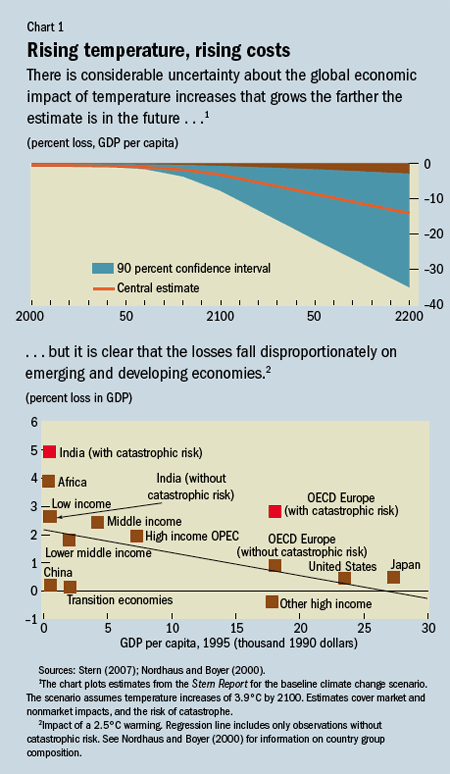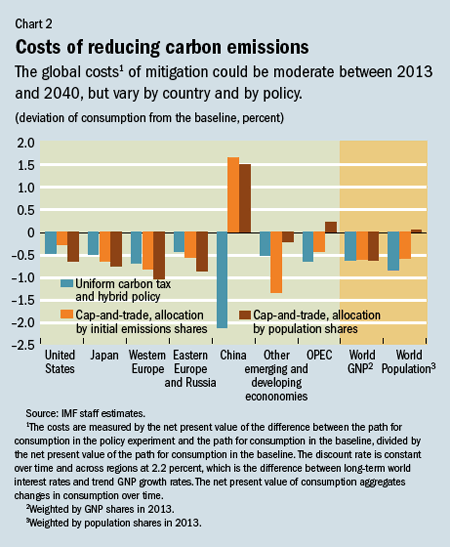> Ñlimate Change & Economy
Climate Change and the Economy
Natalia Tamirisa
Policies to reduce the emission of greenhouse gases need not hobble the economy
Addressing climate change and the economic damage it will likely bring presents policymakers with a dilemma. The benefits of policy action are uncertain and would accrue largely to future generations, whereas the costs of policies run the risk of being more immediate and extensive. At the same time, the costs of inaction are irreversible, potentially catastrophic, and likely to hit poorer countries harder than developed ones. Moreover, even if the greenhouse gas (GHG) emissions that accumulate in the atmosphere and warm the climate stopped immediately, temperatures would rise for some decades because of the emissions already accumulated.
For these reasons, economic policymakers increasingly recognize that policies will have to be adopted both to mitigate global warming, by slowing and ultimately reversing the growth of GHG emissions, and to adapt to the effects of the emissions that have already occurred and will occur in the coming decades. And they agree that mitigation policies in particular can have rapid and wide-ranging consequences.
To shed light on how mitigation policies would affect countries’ economies, the IMF recently undertook a study comparing alternative policy designs — taxes on GHG emissions, emissions permit trading, and hybrid schemes combining elements of both policies. The encouraging news is that the analysis shows that climate change can be addressed without either hurting macroeconomic stability and growth or putting an undue burden on the countries least able to bear the costs of policies. In other words, if policies are well designed, their economic costs should be manageable.
Potential economic damages
A wide range of uncertainty surrounds any estimate of economic damage from climate change. But the damage could be large at high degrees of warming. In a U.K. study by Nicholas Stern, he estimates that the loss in GDP per capita by 2200 under his baseline climate scenario (with relatively high emissions and including market and nonmarket impacts and catastrophic risk) ranges from about 3 percent to 35 percent (90 percent confidence interval), with a central estimate of 15 percent (Chart 1, panel 1). Most other studies show that if temperature increases are less than 3°C (from 1990–2000 levels), average losses should be contained at or below 3 percent of world GDP. However, estimates of damage often suffer from incompleteness — they rarely cover nonmarket damage, the risk of local extreme weather and socially contingent events, and the risks of longer-term global catastrophes — and are incomparable in methodology. Studies typically do not examine the dynamics of damage from rising GHG concentrations.

It is hard to estimate damage from climate change with precision, for several reasons. First, scientific knowledge about the physical and ecological processes underlying climate change is a work in progress. For example, it is unclear how rapidly GHGs will accumulate in the atmosphere, how sensitive climate and biological systems will be to increases in the concentration of those gases, and where the “tipping points” are beyond which catastrophic climate events — such as the melting of the west Antarctic ice sheet or permafrost, a change in monsoon patterns, or a reversal of the Atlantic Thermoline Circulation — would occur. Second, it is difficult to estimate how well people will be able to adapt to new climate conditions. And third, it is difficult to put a current value on damage that would be incurred by future generations.
Moreover, the low estimates of global damage mask a large variation across countries (see Chart 1, panel 2). Climate change will be felt earlier and much more acutely by less developed countries, at least in relation to the size of their economies. Such economies depend more on climate-sensitive sectors (such as agriculture, forestry, fishing, and tourism), have less healthy populations that are more vulnerable to changes in the environment, and offer fewer public services, which also tend to be of lower quality. The regions that are likely to be hurt the most by climate change include Africa, south and southeast Asia, and Latin America. India and Europe are exposed to catastrophic risk from a change in monsoon patterns and the reversal of the Atlantic Thermoline Circulation, respectively. In contrast, China, North America, advanced Asian countries, and transition economies (especially Russia) are less vulnerable and may even benefit at low degrees of warming (for example, from better crop yields).
Facilitating adaptation
Of course, societies have historically shown an ability to adapt to changing environmental conditions, and individuals and firms can be expected to adjust their behavior to changing climate conditions — for example, by planting more drought-resistant crops and moving away from coastal areas exposed to increased flooding and hurricanes. But governments will also have to get involved in the adaptation process because of possible market failures (individual firms and households unable to incorporate the full social benefits of adaptation into their decision making), the need for public goods and services to support adaptation, or limitations to the private sector’s capacity to adapt — for example, in poor countries.
Quantitative analyses of adaptation costs are scant, but studies focusing on public sector costs suggest that adaptation may put a strain on government budgets, especially in developing countries that have weak adaptation capacity and are likely to be severely affected by climate change. Cost estimates for developing countries run into tens of billions of dollars a year, comparable to estimates for advanced countries. Moreover, these estimates are likely to be low because they do not take into account some likely costs, such as those arising from greater volatility of weather patterns.
The best ways to improve a country’s ability to adapt to climate change include the following:
- Economic and institutional development. Development helps countries diversify away from heavily exposed sectors; improves access to health, education, and water; and reduces poverty. Higher-quality institutions also strengthen countries’ abilities to adapt to climate change.
- Fiscal self-insurance. Government budgets must allow for adaptation expenditures, and social safety nets must be strengthened, especially in countries that will be severely affected. External financing may be needed to help poorer countries whose domestic resources are far short of what are needed—on this front, the UN has just launched an effort to provide such financing, a step in the right direction.
- The choice of the exchange rate regime and labor market and financial sector policies. These choices can encourage firms and people to adjust to the abrupt shocks (such as extreme weather events) that are likely to accompany climate change. A flexible exchange rate regime and financial and labor market reforms that make capital and labor more adaptable may help reduce the macroeconomic cost of extreme weather shocks. Such shocks typically destroy capital investments and disrupt production, and adjusting to them requires moving people and capital across and within sectors. Many of these policies can be implemented fairly quickly and at a small cost to the budget.
- Financial markets. These markets can reduce the macroeconomic costs of adapting to climate change by generating price signals that create incentives for people to move to lower-risk areas and reallocating capital to newly productive sectors and regions (see “The Greening of Markets” in this issue). The financial markets’ capacity to diversify costs and spread the risks to those most willing and able to bear them will also help reduce the social costs of adaptation.
Curbing GHG emissions
But adaptation is not enough. To mitigate the consequences of global warming, GHG emissions must be reduced. If a price is put on GHG emissions commensurate with the damage they cause, consumers and businesses would have incentives to shift from producing and consuming goods that give rise to large quantities of emissions to creating clean goods and technologies. Such a price for GHG emissions is often called a carbon price, reflecting the fact that, among all GHGs, carbon dioxide is the main contributor to the climate problem.
Many policy instruments have been considered for mitigation purposes. They include, among other things, taxeson GHGemissions (carbon taxes); cap-and-trade schemes, in which the government restricts the quantity of emissions firms can produce but allows firms to trade their emissions rights; and hybrid policies combining elements of carbon taxes and cap-and-trade schemes.
Which mitigation policies are best? Carbon taxes have a big advantage over cap-and-trade schemes because they result in a stable price for emissions, which is critical for firms making long-term decisions about investment in low-emissions technologies. They also generate revenues that can be used to enhance efficiency (by lowering other taxes) or equity (by compensating groups disadvantaged by policy). However, under carbon taxes, the quantity of emissions reductions is uncertain, and taxes may be politically difficult to implement. That said, there are ways to reduce the disadvantages of cap-and-trade schemes — in the process, creating a hybrid instrument. Price volatility, for example, can be reduced by introducing safety valves that would allow the government to sell some temporary permits when they exceeded some prespecified “trigger” price. Hybrid policies can also provide for a simultaneous targeting of emissions prices (over the short run) and emissions levels (over the long run).
Weighing mitigation policies
What will the economic costs of a given mitigation policy be for the global economy and individual countries’ economies? The IMF examined this question using a global dynamic model — the 2007 version of the so-called G-cubed model (McKibbin and Wilcoxen, 1998) (see box).
|
Why G-cubed?
The G-cubed model is well suited for evaluating how the effects of carbon pricing policies would unfold over time and across countries. Modeling of relative prices helps describe how rising carbon prices would encourage the substitution of cleaner technologies for carbon-intensive ones, affect the movement of spending away from emissions-intensive goods, and impact the terms of trade and the balance of payments. The latter reflects not only trade flows, but also international capital flows, which have received little emphasis in models used for climate policy analysis.
The eventual benefits of mitigation policies are not modeled in G-cubed, but this is not a major drawback of the analysis, which focuses on the costs of mitigation during the three decades following their introduction. Over such a horizon, the benefits of policies are expected to be small, given the slow feedback between changes in the flow of emissions and climate. G-cubed simulations are intended to illustrate the economic mechanisms at work following the introduction of mitigation polices and should not be taken as longterm macroeconomic forecasts. Although alternative sources of energy, such as biofuels, nuclear, and renewables, are not modeled explicitly, substitutions from fossil fuels into capital, as well as energy efficiency improvements, can be interpreted as substitution toward these sources of energy. Technology is assumed to be transferable across countries.
|
Carbon tax and a hybrid with a safety valve. The modeling exercise started by examining the macroeconomic effects of a global mitigation policy that requires countries to agree on a common carbon price: a uniform global carbon tax or a hybrid scheme whereby countries commit to a common safety valve (with the price of additional permits set to the rate of the carbon tax). All countries are assumed to introduce a common carbon price in 2013 and make a credible commitment to keep it in place over the long run, adjusting the rate as necessary to achieve a global emissions path that peaks around 2040 and then gradually declines to 60 percent of the 2002 levels by 2100. To achieve such a profile, the carbon price would have to rise gradually over time, reaching $71 per ton by 2040 (an average annual rate of $2.60 per ton of carbon). This corresponds to a 17 cent increase in the price of a gallon of gasoline by 2040 and a $27 increase in the price of a ton of lignite coal.
Faced with paying for their emissions of carbon, firms in all countries start changing technology, moving away from carbon-intensive inputs. Households alter their consumption patterns, also moving away from carbon-intensive goods. With higher carbon prices raising costs for firms, productivity and output fall. Aggregate investment falls because the average marginal product of capital is lower, and consumption follows declines in real incomes. To the extent that some firms and households are forward looking, they would react immediately to the anticipated future prices, which makes policy more effective. Although the levels of real activity fall permanently relative to the baseline, the shock has only a temporary effect on GNP growth rates: over time, they return to the baseline levels. Current accounts tend to improve in countries that considerably reduce emissions, because declines in investment in such countries outweigh declines in savings.
The total abatement costs vary across countries, depending on how efficient they are in reducing emissions and by how much they reduce them. The costs are the highest for China — by far the least efficient economy in the use of energy (producing nine times more emissions per unit of output than Japan and five times more than the United States). China can reduce emissions at the lowest incremental cost by improving the efficiency with which firms and households use energy. The net present value of consumption in China declines by about 13.4 percent from the baseline levels by 2040 (see Chart 2). For other economies, and the world as a whole, the decline in the net present value of consumption is about 1.2 percent for the same period. When measured in terms of the bundle of goods produced, the costs are higher, with the net present value of world GNP declining by about 2 percent from the baseline by 2040. But this would still leave world GNP two-and-a-half times higher in 2040 than in 2007. (The study focused on GNP as a measure of output because, in contrast to GDP, GNP takes into account the value of transfers between countries, which may occur particularly under the cap-and-trade policies.)

The total costs of mitigation in G-cubed are higher than in many other studies (see, for example, U.S. CCSP, 2007), but within the range of estimates reported by the Intergovernmental Panel on Climate Change (2007). The main reason for higher estimates is that this study assumes relatively strong emissions growth in the baseline and uses conservative assumptions about the availability of the so-called backstop technologies, which allow output to be produced without any emissions of GHG.
Cap-and-trade policy. Next, the study compared the effects of the price-based policies to those of a global policy that requires countries to agree on an initial allocation of emissions rights and international trade of these rights. Each economy receives emissions rights for each year from 2013 onward, which are proportional to its share of global emissions in 2012. Emissions permits can be traded internationally, which establishes a common price. Economies with higher incremental (or marginal) abatement costs (MACs) — that is, the costs of an incremental reduction in emissions — buy permits from economies with lower MACs, compensating them for undertaking more abatement than implied by their share of emissions. Hence, the actual emissions paths of individual economies differ from their initial allocations of permits, whereas the world emissions path is consistent with the targeted profile.
For most economies, transfers are small and the macroeconomic effects of the cap-and-trade policy are similar to those of the carbon tax and the hybrid. For China (a recipient), other emerging and developing economies (payers), and economies in the Organization of the Petroleum Exporting Countries (recipients), transfers reach 6 percent, 11.2 percent, and 1.2 percent of GNP, respectively, by 2040. China receives the largest transfers because it is comparatively inefficient in its use of energy and can reduce emissions at a much lower cost than other economies. Advanced economies, as well as other emerging and developing economies, buy emissions rights from China because emissions reductions are highly costly for these countries. The costs for economies paying transfers (Europe, Japan, Russia, and other emerging and developing economies) are higher under the cap-and-trade scheme than under the carbon tax and the hybrid policy, whereas the costs for the economies receiving transfers (China, OPEC, and the United States) are lower.
Although most studies predict that advanced economies — especially Western Europe and Japan — would have to pay for emissions permits, there is no consensus about international transfers for emerging market economies. Such countries have high growth potential, which implies high future demand for emissions rights, but they also emit a large amount of carbon dioxide per unit of output, suggesting much room for efficiency gains and the ability to sell emissions rights.
Alternative allocation rules. The pattern of international transfers and the macroeconomic effects of cap-and-trade schemes are highly sensitive to how emissions rights are allocated. Suppose each economy receives emissions rights not according to its initial share of emissions, but according to its share of world population in each year from 2013 onward. This would change the pattern of international trade in permits and the macroeconomic effects substantially, with other emerging and developing economies now selling permits and receiving transfers, in the amount of 1.2 percent of GDP in 2040, which reduces the cost of mitigation for these countries.
Guiding principles
What lessons can we glean for policymakers trying to contain the potentially adverse macroeconomic effects of mitigation? Carbon-pricing policies must
- Be long-term and credible. It is important to establish a steadily rising time path for carbon prices that people and businesses believe in. Increases in world carbon prices then need not be large — say a 1 cent initial increase in the price of a gallon of gasoline that rises by an additional cent every two years. Such gradual increases, if started early, would allow the cost of adjustment to be spread over a longer period of time.
- Require all groups of countries — advanced, emerging market, and developing — to start pricing their emissions. Any policy framework that does not include emerging and developing economies (particularly, large and fast-growing economies such as Brazil, China, India, and Russia) would be extremely costly and politically untenable, because 70 percent of total emissions during the next 50 years are projected to come from these and other emerging and developing economies.
- Establish a common world price for emissions. This would ensure that emissions are reduced where it is least costly to do so. Emerging and developing economies, in particular, are likely to be able reduce emissions much more cheaply than advanced countries. For example, if China and India have access to technologies similar to those available in Japan and Europe, they could cut emissions dramatically by improving the efficiency with which they use energy and by reducing reliance on coal. The difference in costs can be significant — for the world as a whole, costs will be 20–40 percent lower if carbon prices are common across countries. Countries would have to harmonize the rate of carbon tax, coordinate trigger prices for the safety valve under a hybrid policy, or allow international trading of emissions permits under a cap-and-trade scheme.
- Be sufficiently flexible to accommodate cyclical economic fluctuations. In periods of high demand, it would be more costly for firms to reduce their emissions, whereas the opposite would be true when demand is low. Abatement costs would be lower if firms could vary their emissions over the business cycle. That would allow achievement of a given average level of emissions reductions over the medium term. In contrast to carbon taxes and hybrid policies, cap-and-trade could prove restrictive in periods of higher growth because of increased demand and prices for emissions permits, unless provisions are made to control price volatility.
- Distribute the costs of mitigation equitably across countries. Some mitigation policies — for example, a uniform tax, a cap-and-trade scheme where permits are allocated based on countries’ share of emissions, or a hybrid policy — would impose high costs on some emerging market and developing economies. Substantial cross-border transfers may be needed to encourage them to participate and to help them deal with the negative impact. Using border tax adjustments to induce countries to join could elicit a protectionist response that would detract from mitigation efforts.
In addition, countries may need to complement carbon pricing with appropriate macroeconomic and financial policies. For example, under a global cap-and-trade regime, transfers from industrial countries that buy permits to emerging and developing economies that sell them could be potentially large — several percentage points of GNP. Such transfers would reduce the costs of carbon pricing policies for emerging and developing countries and would encourage them to participate. However, the transfers might also cause real exchange rates in the recipient countries to appreciate considerably, making some sectors of the economy less competitive. Such macroeconomic effects can be reduced if countries save a portion of these inflows, continue to improve the business environment, and, depending on their exchange rate regime, allow appreciation to take place at least partly through the nominal exchange rate rather than through inflation.
Finally, capital and technology flows can help reduce the costs of mitigation by helping allocate abatement to the least costly destinations while making abatement easier to achieve through the use of modern technology. And initiatives by major advanced economies to subsidize the transfer of clean technologies to emerging and developing countries can usefully complement a global commitment to contain carbon emissions through a broadly accepted global carbon-pricing framework.
Source: International Monetary Fund
<< Previous page
---
Next page >>
TOP
|





